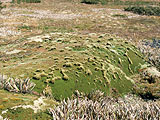 |
|
|
|
|
|
|
Similar to the Australian mainland, the mountains of Tasmania are just high enough to allow for a true alpine flora. The treeline is formed by deciduous Nothofagus cunninghamii at ca. 1100 m elevation. An extremely species-rich dwarf shrub belt makes an impressive contrast to any N-hemisphere alpine dwarf shrub belt. The climate is humid and cool temperate, with a lot of rain and fog, so water shortage is an unknown phenomenon for these plants. Most examples are from the Cradle Mts. region. |
|
1 - Celmisia sp. (Asteraceae) and the fern Gleichenia alpina (Gleicheniaceae) at 1250 m, with the Cradle Mts. (1545 m) in the rear. |
|
|
2 - Small tussocks of Danthonia sp. (Poaceae), "snow grass", at 1250 m in the Cradle Mts. |
3 - Large, intermingled flat cushion plants are a most typical feature of Tasmania's alpine flora. Most of the species are Asteraceae (e.g. Abrotanella sp.), but there are also small Dracocephalum sp. (Lamiaceae) and Pernettya sp. (Ericaceae) species, with grasses or pockets of Celmisia sp. (Asteraceae) rosettes often finding safe sites on such cushions. |
4 - Flat cushions of the light coloured Pterygopappus lawrencii (Asteraceae) at 1250 m. |
|
5 - Gaultheria depressa, an Ericaceae dwarf shrub species also found in New Zealand (Cradle Mts., 1200 m). |
6 - Podocarpus lawrencii (Podocarpaceae), a conifer tree, which becomes a cushion shaped shrub at 1200 m in the Cradle Mts. |
7 - Gentiana diemensis (Gentianaceae), the sole gentian in Tasmania (Cradle Mts., 1250 m). |
8 - A selection of dwarf shrub shoots belonging to genera like Epacris (Ericaceae), Oxylobium (Fabaceae), Orites (Proteaceae), Olearia (Asteraceae), Coprosma (Rubiaceae), Tasmannia (Winteraceae), Gaultheria (Ericaceae), etc. (near Crater Lake, 1080 m). |
29 August 2011 |
||
| |
||








